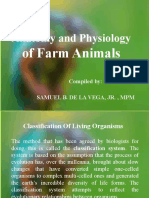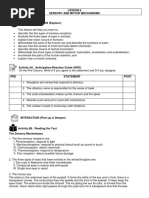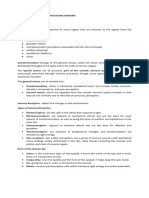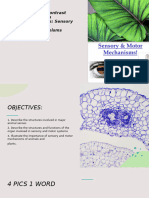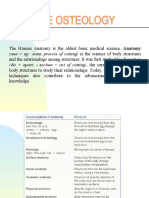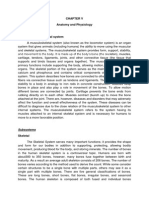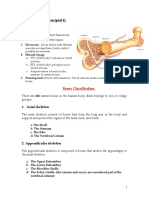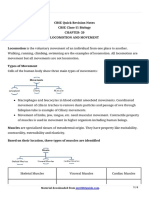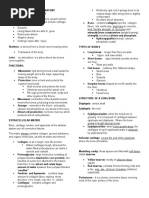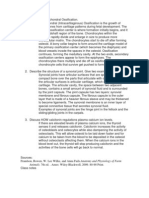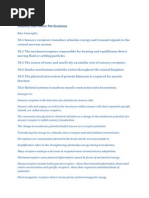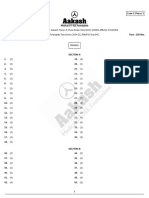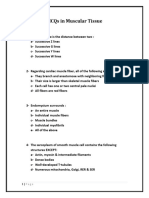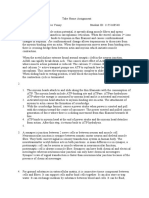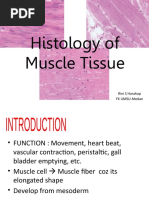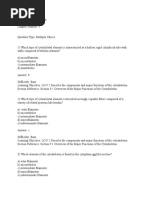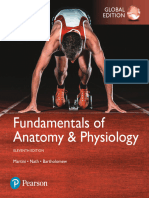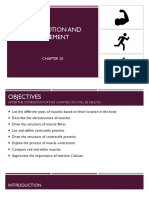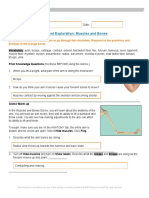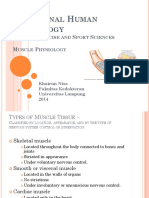8 - Sensory
8 - Sensory
Uploaded by
Niña VirayoCopyright:
Available Formats
8 - Sensory
8 - Sensory
Uploaded by
Niña VirayoOriginal Title
Copyright
Available Formats
Share this document
Did you find this document useful?
Is this content inappropriate?
Copyright:
Available Formats
8 - Sensory
8 - Sensory
Uploaded by
Niña VirayoCopyright:
Available Formats
VIII.
SENSORY AND MOTOR MECHANISMS GENERAL BIOLOGY 2
4TH QUARTER
1. Sensory receptors
Mechanoreceptors respond to physical stimuli such as sound or touch
Thermoreceptors respond to temperature
Chemoreceptors detect chemicals
Photoreceptors respond to light
Pain receptors detect possible tissue damage
2. Three types of eyes in animals
Eye cups in flatworms and other invertebrates
Compound eyes in insects and arthropods
Single lens eyes in squid
3. Parts of the human eye and how “seeing” occurs
The sclera is the outermost layer of the eyeball. It forms the white of the eye and in front, there is a transparent
cornea. The conjunctiva lines the eyelids and the front of the eyeball. It helps keep the eyes moist. The sclera
surrounds the choroid. The iris giving the eye its color, is formed from the choroid. Vision starts when light
passes through the pupil and into a transparent lens that focuses images on the retina. The retina contains
photoreceptor cells which transduce light energy into action potentials. These nerve impulses travel along the
optic nerve to the corresponding visual areas of the brain. An image is then formed.
The photoreceptor cells are rods and cones. Rod cells use the pigment called rhodopsin. They are used for
night vision and can detect only shades of gray and not color. Cone cells distinguish various colors and they
are sensitive to bright light.
4. Parts of the human ear and how “hearing” is achieved
The outer ear lobes catch sound waves and channel them to the eardrums. From the eardrum, the middle
ear amplifies the sound wave vibrations to three small bones – the hammer, anvil and stirrup. The sound
waves travel to the oval window. The Eustachian tube equalizes air pressure in the middle ear and outer ear.
The hearing organ is in the inner ear, composed of several channels of fluid wrapped in a spiral cochlea. This
is encased in the bones of the skull. Vibrations in the oval window produce pressure waves. These waves
travel through the upper canal to the tip of the cochlea, enter the lower canal and fade away. Pressure
waves of the upper canal push down to the middle canal and the membrane below this canal vibrates.
These vibrations stimulate hair cells attached to the membrane by moving them against the overlying tissue.
The hair cells are able to develop receptor potentials causing release of neurotransmitters that induce action
potentials in the auditory neurons.
5. The senses of smell and taste
The senses of odor and taste are interrelated. Chemoreceptors in the nose detect molecules, differentiated
into numerous types of odor. In the upper portion of the nasal cavity, there are olfactory chemoreceptors.
Odor molecules enter the nose and bind to specific receptor molecules on the chemoreceptor cilia. This
event triggers receptor potentials.
In the tongue, chemoreceptors in taste buds detect salty, bitter, sweet and sour tastes. Taste perception is
due to similar signal mechanisms as mentioned above for smell. What one “tastes” is actually “smell” or odor.
The common cold (due to a virus) can disrupt our sense of smell, thus, we lose taste for the food.
Motor Systems
1. Animal Locomotion
Animals have to move to find food and sexual partners. To avoid predators and adjust to varying
environmental conditions, animals exhibit different ways of moving.
Several means of animal locomotion: walking, running, swimming, flying, crawling, hopping, gliding.
2. Skeletal Systems
Three types of skeleton:
Hydrostatic skeleton which a volume of fluid is held under pressure. This is common in aquatic and
burrowing animals. An example is the Hydra and other invertebrates with a semi-enclosed body cavity
made of a few layers of cells. There is no solid “bone” but the animal under aquatic pressure can stay
upright and move. Earthworms have smooth muscles and fluid-filled body compartments.
Rigid, armor-like coverings characterize an exoskeleton. Muscles are attached inside. Joints are thin and
flexible. The best examples are found in arthropods (insects, crustaceans). When insects grow, they shed
off their old “armor” and grow a new one. Cite other examples such as those in clams and snails
An endoskeleton consists of rigid but flexible support made of bones, cartilage surrounded by masses of
muscles. In sponges, cells are supported on spicules. The endoskeleton of echinoderms is made from
calcium plates underneath the skin.
3. Human Skeletal System
The skeletal system consists of bone, cartilage, tendons, and ligaments.
Functions of the Skeletal System
Cartilage provides a model for bone formation and growth, provides a smooth cushion between adjacent
bones, and provides firm, flexible support.
Tendons attach muscles to bones, and ligaments attach bones to bones.
The skeletal system provides the major support for the body.
Bone protects internal organs.
Joints allow movement between bones.
Bones store and release minerals as needed by the body.
Bone marrow gives rise to blood cells and platelets.
Connective Tissue
Connective tissue consists of matrix and the cells that produce matrix.
Varying amounts of collagen, proteoglycan, and mineral in the matrix determine the characteristics of the
connective tissue.
General Features of Bone
Long bones consist of diaphysis (shaft), epiphysis (ends), and epiphyseal (growth) plates. The diaphysis
contains a medullary cavity, which is filled with marrow, and the end of the epiphysis is covered by articular
cartilage.
Compact Bone
Compact bone tissue consists of osteons.
Osteons consist of osteocytes organized into lamellae surrounding central canals.
Cancellous Bone
Cancellous bone tissue consists of trabeculae without central canals.
Bone Ossification
Bone ossification is either intramembranous or endochondral.
Intramembranous ossification occurs within connective tissue membranes.
Endochondral ossification occurs within cartilage.
Bone Growth
Bone growth occurs by apposition. Bone elongation occurs at the epiphyseal plate as chondrocytes
proliferate, hypertrophy, die, and are replaced by bone.
Bone Remodeling
Bone remodeling consists of removal of existing bone by osteoclasts and deposition of new bone by
osteoblasts.
Bone Repair
During bonne repair, cells move into the damaged area and form a callus, which is replaced by bone.
Bone and Calcium Homeostasis
Osteoclasts remove calcium from bone, causing blood calcium levels to increase.
Osteoblasts deposit calcium into the bone, causing blood calcium levels to decrease.
Parathyroid hormone increases bone breakdown, whereas calcitonin decreases bone breakdown.
Axial skeleton includes the skull, vertebral column, and thoracic cage.
Appendicular skeleton - bones of the appendages (arms, legs, fins) and bones linking the appendages to the
axial skeleton – the pectoral and pelvic girdles.
Articulations
An articulation is a place where bones come together.
Fibrous joints consist of bones united by fibrous connective tissue. They allow a little or no movement.
Cartilaginous joints consist of bones united by cartilage, and they exhibit sight movement.
Synovial joints consist of articular cartilage over the uniting bones, a joint cavity lined by a synovial
membrane and containing synovial fluid, and a joint capsule. They are highly movable joints. Synovial joints
can be classified as plane, saddle, hinge, pivot, ball-and-socket, or ellipsoid.
Types of Movement
The major types of movement include flexion/extension, abduction/adduction, pronation/supination,
eversion/inversion, rotation, protraction/retraction, elevation/depression, excursion, opposition/reposition,
and circumduction.
4. Muscular System
Functions of the Muscular System
The muscular system functions to produce body movement, maintain posture, cause respiration, produce
body heat, produce movement involved in communication, constrict organs and vessels, and pump blood.
Characteristics of Skeletal Muscle
Skeletal muscle has contractility, excitability, extensibility, and elasticity.
Structure
Muscle fibers are organized into fasciculi, and fasciculi are organized into muscles by associated connective
tissue.
Each skeletal muscle fiber is a single cell containing numerous myofibrils.
Myofibrils are composed of actin and myosin myofilaments.
Sarcomeres are joined end to end to form myofibrils.
Muscle Contraction
Action potentials are carried along T tubules to the sarcoplasmic reticulum, where they cause the release of
calcium ions.
Calcium ions, released from the sarcoplasmic reticulum, bind to the actin myofilaments, exposing
attachment sites.
Myosin forms cross-bridges with the exposed actin attachment sites.
The myosin molecules bend, causing the actin molecules to slide past; this is the sliding filament model. The H
and I bands shorten, the A bands do not.
This process requires ATP breakdown.
A muscle twitch is the contraction of a muscle fiber in response to a stimulus; it consists of a lag phase,
contraction phase, and relaxation phase.
Tetanus occurs when stimuli occur so rapidly that a muscle does not relax between twitches.
Small contraction forces are generated when small numbers of motor units are recruited, and greater
contraction forces are generated when large numbers of motor units are recruited.
Energy is produced by anaerobic (without oxygen) and aerobic (with oxygen) respiration.
After intense exercise, the rate of aerobic metabolism remains elevated to repay the oxygen debt.
Muscle fatigue occurs as ATP is depleted during muscle contraction. Physiological contracture occurs in
extreme fatigue when a muscle can neither contract nor relax.
Muscles relax either isometrically (tension increases, but muscle length stays the same) or isotonically (tension
remains the same, but muscle length decreases).
Muscle tone consist of a small percentage of muscle fibers contracting tetanically and is responsible for
posture.
Muscles contain a combination of slow-twitch and fast-twitch fibers.
Slow-twitch fibers are better suited for aerobic metabolism, and fast-twitch fibers are adapted for anaerobic
metabolism.
Sprinters have more fast-twitch fibers, whereas distance runners have more slow-twitch fibers.
You might also like
- The Science of RunningDocument459 pagesThe Science of RunningRenan Sequini Favaro100% (2)
- Anatomy and Physiology of Farm AnimalsDocument157 pagesAnatomy and Physiology of Farm AnimalsOliver Talip100% (2)
- Anatomyand Physiology Ratio Activity SAS 8-14Document8 pagesAnatomyand Physiology Ratio Activity SAS 8-14Clarisse Biagtan CerameNo ratings yet
- Lesson 8 Sensory and Motor MechanismDocument8 pagesLesson 8 Sensory and Motor MechanismBrent PatarasNo ratings yet
- Lesson 8 Sensory Motor MechanismDocument4 pagesLesson 8 Sensory Motor Mechanismcabahugmarlon2.5No ratings yet
- Q2 L4 HandoutDocument4 pagesQ2 L4 HandoutmiatamayoqtNo ratings yet
- The Human Body Terms: Dr. SuwonoDocument6 pagesThe Human Body Terms: Dr. SuwonoRed DemonNo ratings yet
- Lesson 7 Sensory (1)Document37 pagesLesson 7 Sensory (1)jarrokitnavarro23No ratings yet
- Locomotion and MovementDocument6 pagesLocomotion and MovementRonaldNo ratings yet
- 11 Biology Notes ch20 Locomotion and MovementDocument3 pages11 Biology Notes ch20 Locomotion and MovementTAN27No ratings yet
- Chronic OsteomyelitisDocument35 pagesChronic OsteomyelitisMelissa Gines100% (2)
- Anatomy and Physiology of Farm AnimalsDocument157 pagesAnatomy and Physiology of Farm AnimalsOliver TalipNo ratings yet
- Immune SystemDocument12 pagesImmune SystemCasper Irra Marcos100% (1)
- Document 5Document22 pagesDocument 5dawidkubiak222No ratings yet
- Chapter-20 Locomotion and Movement: Is The Voluntary Movement of An Individual From One Place ToDocument8 pagesChapter-20 Locomotion and Movement: Is The Voluntary Movement of An Individual From One Place ToLishaNo ratings yet
- The OsteologyDocument20 pagesThe OsteologycfcjnrNo ratings yet
- Pathophysio of OsteomyelitisDocument6 pagesPathophysio of OsteomyelitisNapPeliyoNo ratings yet
- Locomotion and Movement VENDocument12 pagesLocomotion and Movement VENSREE GANESHNo ratings yet
- Skeletal SystemDocument23 pagesSkeletal SystemteametafereNo ratings yet
- Anatomy and PhysiologyDocument19 pagesAnatomy and PhysiologyJo BesandeNo ratings yet
- Skeletal System Anatomy and PhysiologyDocument29 pagesSkeletal System Anatomy and PhysiologyKBD100% (2)
- 11 Biology Notes ch20 Locomotion and Movement PDFDocument3 pages11 Biology Notes ch20 Locomotion and Movement PDFRamachandranPerumalNo ratings yet
- Anatomy (Ortho)Document13 pagesAnatomy (Ortho)Jo BesandeNo ratings yet
- THE SPECIAL SENSESDocument34 pagesTHE SPECIAL SENSESighhouse.3No ratings yet
- Human Anatomy 5th Edition Saladin Solutions Manual all chapter instant downloadDocument34 pagesHuman Anatomy 5th Edition Saladin Solutions Manual all chapter instant downloadwenharfesoj100% (1)
- Relationship To Other Organ SystemsDocument11 pagesRelationship To Other Organ SystemsVern NuquiNo ratings yet
- Chapter 20Document6 pagesChapter 20netram rajora100% (1)
- The Human Body Terms: Dr. SuwonoDocument5 pagesThe Human Body Terms: Dr. SuwonoRed DemonNo ratings yet
- Bio 20Document6 pagesBio 20aanshisingh8884No ratings yet
- Bone As A Living Dynamic TissueDocument14 pagesBone As A Living Dynamic TissueSuraj_Subedi100% (6)
- Ministry of Education Academia Latina Level: 11"A ScienceDocument18 pagesMinistry of Education Academia Latina Level: 11"A ScienceleoNo ratings yet
- Test No.2 AhpDocument9 pagesTest No.2 Ahpdilshabeum24No ratings yet
- Locomotion and Movement Class 11 Notes CBSE Biology Chapter 20 (PDF)Document13 pagesLocomotion and Movement Class 11 Notes CBSE Biology Chapter 20 (PDF)ASHISH MALAVNo ratings yet
- Anatomy Make-Up WorkDocument8 pagesAnatomy Make-Up WorkMartin BotrosNo ratings yet
- Human Movement and Bones: Ms. Marcheli Alexandra, S.PD Junior High Sekolah Global Mandiri Cibubur 2018-2019Document19 pagesHuman Movement and Bones: Ms. Marcheli Alexandra, S.PD Junior High Sekolah Global Mandiri Cibubur 2018-2019Andy WarholNo ratings yet
- Reviewer Zoo LecDocument27 pagesReviewer Zoo LecayeyedumpNo ratings yet
- Functions of The Skeletal System TopicDocument21 pagesFunctions of The Skeletal System TopicTUNGCALING ACNo ratings yet
- Bio 11 - Zoology - Experiment 20 - Types of Tissues: Muscular TissueDocument17 pagesBio 11 - Zoology - Experiment 20 - Types of Tissues: Muscular TissueDenise Cedeño100% (1)
- Untitled Document 35Document9 pagesUntitled Document 35deekshana0307No ratings yet
- The Skeletal SystemDocument7 pagesThe Skeletal SystemKathleenJoyGalAlmasinNo ratings yet
- Anaphy Exercise 5 - SKELETAL AND ARTICULAR SYSTEMDocument12 pagesAnaphy Exercise 5 - SKELETAL AND ARTICULAR SYSTEMKenzoNo ratings yet
- HAP imps 2024 -25 question and ans.Document21 pagesHAP imps 2024 -25 question and ans.sritamahiya07No ratings yet
- Natural Sciences - 03 Cell Organisation To Human Systems 2Document1 pageNatural Sciences - 03 Cell Organisation To Human Systems 2leah.hendricksNo ratings yet
- Functions of THDocument29 pagesFunctions of THNatukunda DianahNo ratings yet
- Skeletal System Bones and Joints HapDocument17 pagesSkeletal System Bones and Joints HapJoanna :DNo ratings yet
- PP13 Human Skeletal System Tissues 1460451284Document65 pagesPP13 Human Skeletal System Tissues 1460451284angie432meNo ratings yet
- SKELETAL SYSTEM ReviewerDocument7 pagesSKELETAL SYSTEM ReviewerKrize Colene dela CruzNo ratings yet
- 11 Biology Notes ch20 Locomotion and Movement PDFDocument6 pages11 Biology Notes ch20 Locomotion and Movement PDFAswin MuruganNo ratings yet
- Chapter Three Biology f4Document7 pagesChapter Three Biology f4hanadmahad424No ratings yet
- Movement-Rigid Strong Bones Is Well Suited ForDocument7 pagesMovement-Rigid Strong Bones Is Well Suited ForEllah GutierrezNo ratings yet
- Assignment #3Document1 pageAssignment #3tensai-samaNo ratings yet
- Chapter 6 Content Review Questions 1-8Document3 pagesChapter 6 Content Review Questions 1-8Rhonique MorganNo ratings yet
- m5 Skeletal SystemDocument33 pagesm5 Skeletal Systemapi-464344582100% (1)
- 02 SkeletalsystemDocument18 pages02 SkeletalsystemhorozukaNo ratings yet
- Sensory and Motor MechanismsDocument4 pagesSensory and Motor Mechanismsapi-270888630No ratings yet
- Anatomical, Physiological and Mechanical Bases of Movements: Body Really Made Of? "Document10 pagesAnatomical, Physiological and Mechanical Bases of Movements: Body Really Made Of? "Jay Carlo BagayasNo ratings yet
- Locomotionclass 11Document4 pagesLocomotionclass 11Akanksha AvasthiNo ratings yet
- Muscular and Skeletal SystemDocument8 pagesMuscular and Skeletal SystemPrasad WasteNo ratings yet
- Pyogenic Discitis Power PointDocument121 pagesPyogenic Discitis Power Pointjav_luv37No ratings yet
- 1707721775Document19 pages1707721775atrayeeganguly8f39No ratings yet
- 14 July Human Skeletal System TissuesDocument52 pages14 July Human Skeletal System TissuessusannzambukaNo ratings yet
- General Histology and Embryology Midterms 1Document24 pagesGeneral Histology and Embryology Midterms 1rvinluan.dentNo ratings yet
- Fortnightly Test Series 2024-25_RM(P3)-Test-04C _keyDocument23 pagesFortnightly Test Series 2024-25_RM(P3)-Test-04C _keyshantanub0709No ratings yet
- Muscle Energy Techniques A Practical Guide for Physical Therapists John Gibbons 2024 scribd downloadDocument65 pagesMuscle Energy Techniques A Practical Guide for Physical Therapists John Gibbons 2024 scribd downloadphedrakssaNo ratings yet
- The Muscular TissueDocument23 pagesThe Muscular TissueMuhammad Salisu IliyasuNo ratings yet
- MCQs in Muscular TissueDocument5 pagesMCQs in Muscular TissueQur' anNo ratings yet
- Muscular SystemDocument4 pagesMuscular SystemDOROLA CRIS JANELICA R.No ratings yet
- Meat Technology NotesDocument147 pagesMeat Technology NotesAbubakar Bello AliyuNo ratings yet
- Bche 4090 1155168548Document7 pagesBche 4090 1155168548Yenny TsaiNo ratings yet
- Biochemistry of Muscles and Connective TissueDocument41 pagesBiochemistry of Muscles and Connective TissueВіталій Михайлович НечипорукNo ratings yet
- Muscle Tissue - Wo AudioDocument33 pagesMuscle Tissue - Wo Audiozahra nabilaNo ratings yet
- BIOENERGETICS - How The Body Converts Food To Energy - Group 7 (MC 102 - Lecture) EDITEDDocument73 pagesBIOENERGETICS - How The Body Converts Food To Energy - Group 7 (MC 102 - Lecture) EDITEDJowe Varnal100% (1)
- Locomotion and MovementDocument8 pagesLocomotion and MovementKajal SinghNo ratings yet
- 807Download Complete Machina Carnis The Biochemistry of Muscular Contraction in its Historical Development 1st Edition Dorothy M. Needham PDF for All ChaptersDocument67 pages807Download Complete Machina Carnis The Biochemistry of Muscular Contraction in its Historical Development 1st Edition Dorothy M. Needham PDF for All Chaptersareebaezeni100% (1)
- Locomotion and MovementDocument88 pagesLocomotion and MovementMd Ali Imam AnsariNo ratings yet
- The Muscular System Learning Enhancement Activity LectureDocument6 pagesThe Muscular System Learning Enhancement Activity LectureNathaniel CornistaNo ratings yet
- K. Pengantar Muskulofisiologi 1, Dr. M. Djauhari W., AIF, PFK, Kamis 28 Oktober 2021Document116 pagesK. Pengantar Muskulofisiologi 1, Dr. M. Djauhari W., AIF, PFK, Kamis 28 Oktober 2021punthadewaNo ratings yet
- Muscular and Nervous Tissue Handout 1Document17 pagesMuscular and Nervous Tissue Handout 1Wheteng YormaNo ratings yet
- Seafoods Chemistry Processing Technology and Quality Fereidoon Shahidi 2024 Scribd DownloadDocument62 pagesSeafoods Chemistry Processing Technology and Quality Fereidoon Shahidi 2024 Scribd Downloadraffenoks45100% (1)
- Muscular SystemDocument17 pagesMuscular SystemNicoleVideñaNo ratings yet
- Anatomy and Physiology of MusculosceletalDocument119 pagesAnatomy and Physiology of MusculosceletalIrgi PutraNo ratings yet
- Full Download Physiological aspects of sport training and performance 2nd ed Edition Jay Hoffman PDF DOCXDocument85 pagesFull Download Physiological aspects of sport training and performance 2nd ed Edition Jay Hoffman PDF DOCXmengelunny6y100% (4)
- CH 09Document39 pagesCH 09abdurNo ratings yet
- Libro MorfoDocument131 pagesLibro MorfotajjyoonjiNo ratings yet
- Meat Quality and FabricationDocument37 pagesMeat Quality and FabricationJessa PabilloreNo ratings yet
- Locomotion and MovementDocument58 pagesLocomotion and MovementdddNo ratings yet
- Gizmo - Muscles and BonesDocument7 pagesGizmo - Muscles and BonesMayaNo ratings yet
- Muscular SystemDocument16 pagesMuscular Systemjgabiran02No ratings yet
- Unctional Uman Hysiology: E S S M PDocument88 pagesUnctional Uman Hysiology: E S S M Pandre andreNo ratings yet

